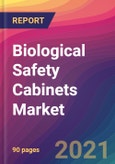Biological safety cabinets or biosafety cabinets include a variety of devices that are equipped with High-efficiency particulate arrestance (HEPA) filters. These containment equipment provide personnel and environment protection form biohazardous constituents.Biological safety cabinets are classified based on specifications based on airflow patterns and velocities, exhaust systems and construction. Some chief international standards for biological safety cabinets are: European Standard EN 12469, American Standard NSF 49, Japanese Standard JIS K 3800, and Australian Standard AS 2252.
For the purpose of this study, the global biological safety cabinets market is segmented based on cabinet types (class), applications and geographical market distribution. Class I, Class II, Class III are the chief biological safety cabinet types. Class II biosafety cabinets are further categorized as type A1, type A2, type B1 and type B2 cabinets. Industrial, research and academics are the prime application areas of biological safety cabinets. Market size and forecast for each mentioned segment and subsegment are provided in this report for the period 2019-2029 (USD Mn), along with respective CAGR (value %) for the period 2021-2029.
Along with quantitative information, qualitative information sets and assessment tools are provided in this study for better analysis of the overall market scenario and future prospects. Information such as market inclination insights and drivers,challenges and opportunities assists the readers for understanding the ongoing trends in the global biological safety cabinets market. Tools such as market positioning of key players, Porter’s five forces analysis and attractive investment proposition provide the readers with insights on the competitive scenario of the global biological safety cabinets market. This report concludes with company profiles section that highlights major information about the key players engaged in development, manufacture and sales of biological safety cabinets market.
For the purpose of this study, the global biological safety cabinets market is categorized as follows:
This product will be delivered within 2 business days.
For the purpose of this study, the global biological safety cabinets market is segmented based on cabinet types (class), applications and geographical market distribution. Class I, Class II, Class III are the chief biological safety cabinet types. Class II biosafety cabinets are further categorized as type A1, type A2, type B1 and type B2 cabinets. Industrial, research and academics are the prime application areas of biological safety cabinets. Market size and forecast for each mentioned segment and subsegment are provided in this report for the period 2019-2029 (USD Mn), along with respective CAGR (value %) for the period 2021-2029.
Geographically, the global biological safety cabinets market is studied for the following regional markets:
- North America
- U.S.
- Canada
- Europe
- U.K.
- Germany
- Rest of Europe
- AsiaPacific
- Japan
- China
- Rest of AsiaPacific
- Middle East and Africa
- Latin America
Along with quantitative information, qualitative information sets and assessment tools are provided in this study for better analysis of the overall market scenario and future prospects. Information such as market inclination insights and drivers,challenges and opportunities assists the readers for understanding the ongoing trends in the global biological safety cabinets market. Tools such as market positioning of key players, Porter’s five forces analysis and attractive investment proposition provide the readers with insights on the competitive scenario of the global biological safety cabinets market. This report concludes with company profiles section that highlights major information about the key players engaged in development, manufacture and sales of biological safety cabinets market.
Based on the type of cabinets, the global biological safety cabinets market is segmented as follows:
- Class I
- Class II
- Type A1
- Type A2
- Type B1
- Type B2
- Class III
- Product protection
- Environmental protection
- Personnel protection
For the purpose of this study, the global biological safety cabinets market is categorized as follows:
- North America
- Europe
- Asia Pacific
- Latin America (LATAM)
- Middle East and Africa (MEA)
This product will be delivered within 2 business days.
Table of Contents
Chapter 1 Preface
Chapter 2 Executive Summary
Chapter 3 Global Biological Safety Cabinets Market Overview
Chapter 4 Global Biological Safety Cabinets Market, By Type, 2019-2029 (USD Mn)
Chapter 5 Global Biological Safety Cabinets Market, By Applications, 2019-2029 (USD Mn)
Chapter 6 Global Biological Safety Cabinets Market, By Geography, 2019-2029 (USD Mn)
Chapter 7 Company Profiles
Companies Mentioned
- ESCO Technologies
- LABCONCO
- Azbil Telstar
- Polypipe
- The Baker Company
- Thermo Fisher Scientific
- AirClean Systems
- NuAire
- Erlab
- Germfree Laboratories Inc.
- Bigneat Containment Technology
- CHC Lab








